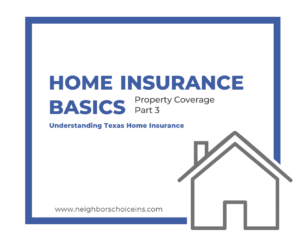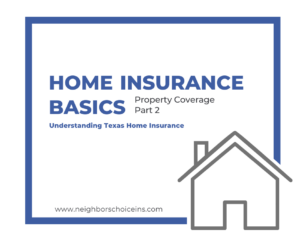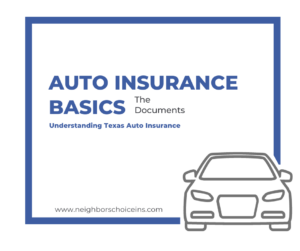Insurance companies offer a variety of home insurance products and solutions for consumers. Home insurance policies vary widely from company to company as well as within a company’s product offering. It’s important to pay attention to the details when selecting a home insurance policy so that you have a better understanding of what may or may not be covered under your insurance policy.
The kind of home insurance policy we are discussing in this blog pertains only to the primary, single-family, owner-occupied residence. Home insurance policies for condos, townhomes, rental properties, etc. are different. It is important to speak with your insurance agent about the kind of home and how it will be used in order to determine the appropriate home policy type.
A home insurance policy is not going to cover anything and everything that may happen related your home and property. The insurance company is careful to spell out what is and is not covered in the Policy Contract. It is your duty as an insured to read and understand your Policy Contract.
Categories of Property on a Homeowners Insurance Policy
The insurance company places the kinds of property that are covered under the home insurance policy into three basic categories. These categories each come with a Coverage Limit and their own set of Perils or Causes of Loss the insurance company is willing cover per property type. The three categories of property are:
Dwelling (Coverage A) – In the case of a home insurance policy, the Dwelling is usually the house and its attached structures. In other words, Dwelling coverage includes the dwelling on the residence premises shown in the Declarations that is used principally as a private residence and its attached structures – not including fences, driveways or walkways.
Dwelling coverage also includes permanently attached property such as carpeting and built-in appliances as well as the materials and supplies located on or next to the residence premises used to construct, alter or repair the dwelling or Other Structures on the residence premises.
We used a term that has not yet been defined – Residence Premises – the residence premises is the address referenced and listed on the Declarations.
Other Structures (Coverage B) – Detached garages, storage sheds, fences, driveways and pools. The structure must be located on the residence premises and set apart from the Dwelling by clear space (they may be connected to the Dwelling by fence or utility line).
Personal Property (Coverage C) – The contents of your home – like furniture, clothing and appliances.
The kinds of loss the insurance company is willing to cover varies by the category the property falls under. Often times, the Dwelling and Other Structures are covered for the same Causes of Loss, while the Personal Property has a different category of losses for which the insurance company will extend coverage. This brings us to the next topic, Named versus Open Peril Coverage.
Named Peril vs Open Peril Coverage
A very important difference between insurance policies has to do with what Perils are covered under the policy. A Peril is a cause of loss or a specific event that causes damage or loss to your property – such as fire or wind (like a tornado). To put it simply, there are two ways insurance companies determine what kinds of events they will or will not cover under the insurance policy. These two ways are expressed through either Named Perils or Open Perils.
For Named Perils, the insurance company lists out the different events that are covered under the home insurance policy. There are two main categories of Perils (though they do vary by policy):
Basic: Fire or Lightning, Sudden or Accidental Damage from Smoke, Windstorm or Hail, Explosion, Aircraft and Vehicles, Vandalism or Malicious Mischief, Riot or Civil Commotion and Theft.
Broad: Basic Perils, plus Falling Objects, Weight of ice, snow, or sleet, Sudden & Accidental discharge/overflow of water or steam, Sudden & Accidental tearing apart, cracking, burning, or bulging of steam or water from water heating system and Falling trees or limbs.
If you were to experience damage or a loss to your home that is not included in the list of Perils on a Named Perils policy, your insurance company would not pay out or reimburse you for the cost to repair. Two examples of a Named Peril policy are an HOA/HO 1 (Basic) and HOA+/HO 2 (Broad). These policies offer Named Perils on both the Dwelling and the Personal Property. Though there are companies that still offer an HOA/HO 1 and HOA+/HO 2, these policies are becoming less and less common as time goes by.
For Open Perils, the insurance company basically says they will cover anything that happens, unless the event or cause of loss is specifically excluded from coverage. This kind of coverage is also known as All Risk coverage. This is the broadest coverage that you can have on a home policy. Exclusions still vary by insurance company, so it is important to read the policy to find out what is excluded. An example of an Open Perils policy is what is called an HO-C or HO 5. The HO-C or HO 5 policy offers Open Perils on both the Dwelling and the Personal Property.
Common Home Insurance Exclusions include: Flood, Earthquake, Damage from termites, insects or rodents, freezing pipes while the home is unoccupied, certain losses to the home if it is vacant for a specified amount of time, wear and tear or maintenance, wind/hail/freezing damage to trees and shrubs, mold, water back-up of sewers and drains and water damage from continuous and repeated leakage or seepage.
The most common type of Home Insurance Policy in Texas is actually a hybrid of Named Peril and Open Peril. This Home Insurance Policy is called an HO-B or HO3. In this kind of insurance policy, the insurance company offers Open Peril coverage on the Dwelling and Other Structures and Named Peril coverage on the Personal Property.
Conclusion
We have established that each category of property has its own Perils or Causes of Loss that the insurance company will insure against – and the lists of Perils and Exclusions vary by insurance company and insurance policy. Differences between insurance policies in regards to the property covered and the Causes of Loss insured against can be big, but they can also subtle. The only way to know what your insurance policy covers is to read your insurance policy. In the next blog, we will discuss Property Coverage Limits.
Disclaimer: This blog is for general informational purposes only. Please remember, for specific information about your coverage and your policy, please read your insurance policy. If there is any conflict between the information in this article and the actual terms and conditions of your policy, the terms and conditions of your policy will apply.
Contact Us!
At Neighbor’s Choice Insurance Agency, we can work with you to make sure you’ve got the insurance coverage you need, while at the same time using all possible credits and discounts to make that coverage affordable. Just give us a call at 817-421-8866 or send us a note at info@neighborschoiceins.com. We want to help you meet your goals, and make sure what’s important to you is protected!





